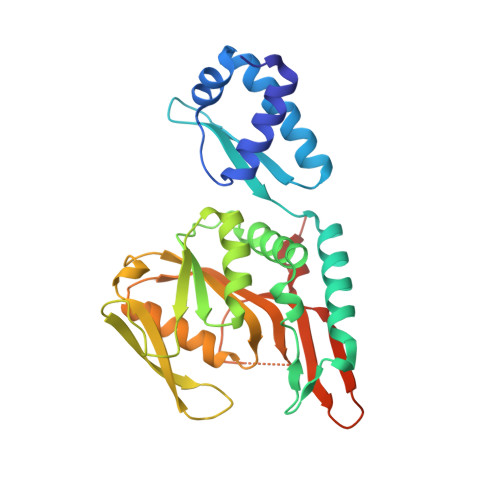The nucleotide messenger (p)ppGpp is an anti-inducer of the purine synthesis transcription regulator PurR in Bacillus.
Anderson, B.W., Schumacher, M.A., Yang, J., Turdiev, A., Turdiev, H., Schroeder, J.W., He, Q., Lee, V.T., Brennan, R.G., Wang, J.D.(2022) Nucleic Acids Res 50: 847-866
- PubMed: 34967415
- DOI: https://doi.org/10.1093/nar/gkab1281
- Primary Citation of Related Structures:
7RMW - PubMed Abstract:
The nucleotide messenger (p)ppGpp allows bacteria to adapt to fluctuating environments by reprogramming the transcriptome. Despite its well-recognized role in gene regulation, (p)ppGpp is only known to directly affect transcription in Proteobacteria by binding to the RNA polymerase. Here, we reveal a different mechanism of gene regulation by (p)ppGpp in Firmicutes: (p)ppGpp directly binds to the transcription factor PurR to downregulate purine biosynthesis gene expression upon amino acid starvation. We first identified PurR as a receptor of (p)ppGpp in Bacillus anthracis. A co-structure with Bacillus subtilis PurR reveals that (p)ppGpp binds to a PurR pocket reminiscent of the active site of phosphoribosyltransferase enzymes that has been repurposed to serve a purely regulatory role, where the effectors (p)ppGpp and PRPP compete to allosterically control transcription. PRPP inhibits PurR DNA binding to induce transcription of purine synthesis genes, whereas (p)ppGpp antagonizes PRPP to enhance PurR DNA binding and repress transcription. A (p)ppGpp-refractory purR mutant in B. subtilis fails to downregulate purine synthesis genes upon amino acid starvation. Our work establishes the precedent of (p)ppGpp as an effector of a classical transcription repressor and reveals the key function of (p)ppGpp in regulating nucleotide synthesis through gene regulation, from soil bacteria to pathogens.
Organizational Affiliation:
Department of Bacteriology, University of Wisconsin-Madison, Madison, WI 53706, USA.















